As we crowded up the air bridge into Apia airport terminal, Bronwyn ended up slightly ahead of me, side by side with a young local man. He was close to seven feet high, and easily twice as broad as Bronwyn; she looked like a child next to him. Out in the airport proper, we realised that this was standard physique for a Samoan. It appeared through our foreign eyes as if we had inadvertently stumbled on a rugby players convention, if you can imagine rugby players walking around wearing skirts stuffed with large bunches of grass to keep out the cool 30-degree Celsius evening breeze.
Friendly taxi-drivers directed us to their competitor, the airport shuttle. Although we were the only two paying tourists, the bus soon filled up and we found ourselves in the midst of a crowd of chattering locals who were taking advantage of the free lift. They were all happy to talk about themselves, and seemed to consider themselves less the citizens of a particular country and more inhabitants of the Pacific islands as a whole. For instance, one young guy, who described himself as Fijian Indian, had been raised in Tonga, and was now living in Samoa because his sister was at university here. We gathered that, if his sister got her degree, then both of them would be trying to move to New Zealand.
The bus detoured off the tarmac and up a muddy track. Apparently all the local guys were going to the same place, and suddenly there it was, a beautiful white mansion in the rain forest. We said our goodbyes, and the bus plunged back into the darkness. We’d been up since 5 am, and it was now 2 am the following morning. The bus rattled through the night, tooting merrily to every other vehicle, almost all of which were taxis, and occasionally at packs of wild dogs hanging around in the road. It was wet and hard to see outside; we had vague impressions of palm trees, but suddenly we came across three beautiful brightly lit churches, one after the other; then it was dark again. Eventually the trees parted, and we were decanted into downtown Apia. We had a vague impression of the sea, and of a small wood-framed building which was our hotel. A smiling woman, who had clearly been waiting up for us, assured us that she had not, and showed us to our sparsely appointed but pleasant room. The night was hot and humid, but bearable under the ceiling fan, and we clambered into the somewhat rickety bed and fell instantly into a deep and undisturbed sleep.
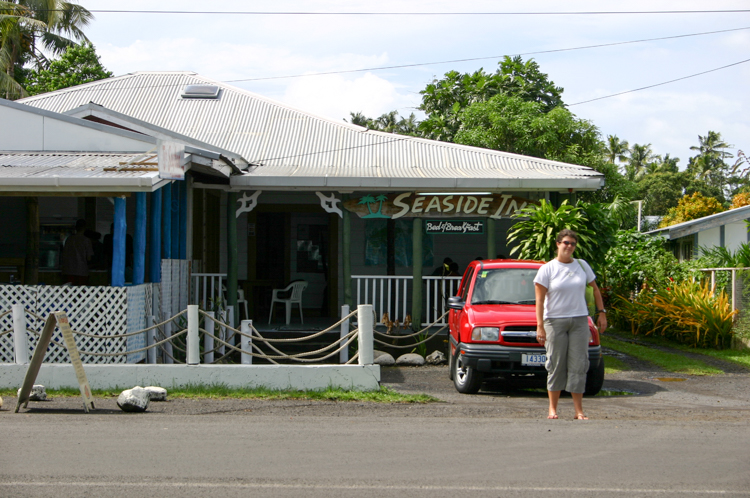
The Seaside Inn, Apia
On the following morning we had arranged to be picked up to go on a kayaking trip. The guy was supposed to pick us up at 08:30, but he didn’t show and we dozed until breakfast, which turned out to consist of white sliced toast and a chunk of pleasant, almost savoury, mango. The coffee was thin and weak, but we had been forewarned and had come prepared with our own ground beans. As we finished our breakfast, an American at the next table begged us for the used coffee grounds from the bottom of our plunger. He said that he’d been in Apia for a while and was dying for a cup with some flavour in it.
Still frazzled from our long trip, we gave the kayak guy until 10:30 and then wandered out into town. Apia is, of course, the capital city of Samoa. On the ground, it is a large-ish village hugging a natural harbour, comprising a couple of shops, the Australian/Canadian combined High Commission, a bank, some insurance companies, and an inordinate number of churches.
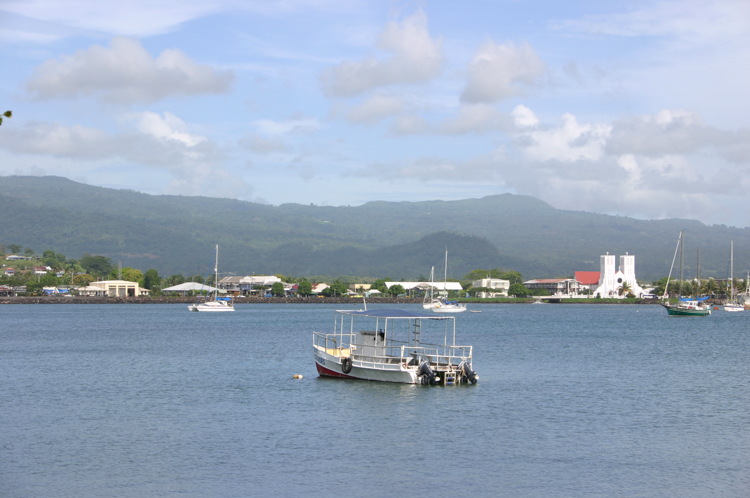
Apia city centre
A handful of visiting yachts swung serenely in the bay, along with two small container ships of the Samoa Shipping Company, and what was apparently a small tramp steamer. In the shallows close by, a fisherman was casting his net.
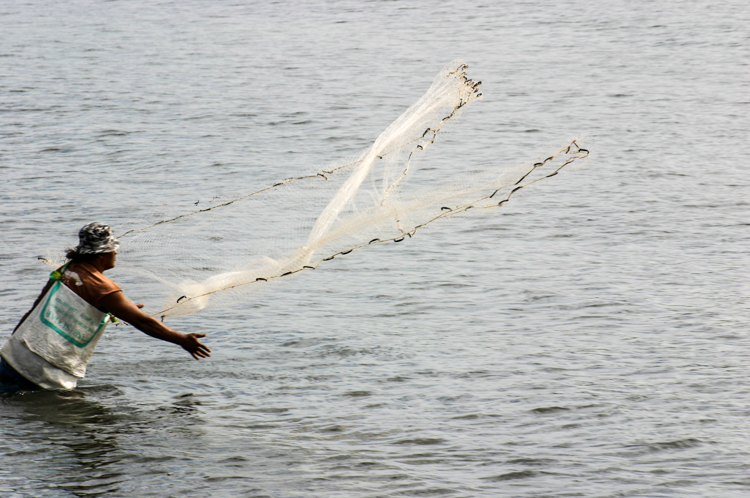
Fishing in Apia harbour
We dropped in to the Green Turtle, a backpackers tour operation, and found that the reason that the kayak guy hadn’t shown, was that we had crossed the International Date Line and it wasn’t even Sunday yet; we were reliving Saturday morning. This meant something of a rethink of our plans, which was quite hard as we were very tired and suffering from the heat, so instead we ambled up and down the only two streets in the city until 13:00 when the shops started closing, at which point we checked back in to this morning’s hotel.
After some discussion with the receptionist, we ordered a taxi to take us across the island to a famous freshwater swimming hole which, we were told, was situated at the Centre for Theological Studies. Samoa has a long history of missionaries from just about every Christian group imaginable, even some of the odder American sects, and many of them have stuck. Each church maintains a very strict hold over its congregation in terms of tithes, and enormous beautifully appointed churches tower everywhere over the often far less salubrious dwellings of the locals. Schooling is highly regarded on Samoa, and the Centre was typically well-kempt and spacious. The taxi driver was content to go to sleep until we’d finished, so we left him to it and went to see what we could find.
All the students were deeply involved in the national pastime of Krikiti. This seems to be played wherever a group of young men get together and is vaguely like cricket but played with a rubber ball, a huge three-cornered bat, and a lot of laughter.
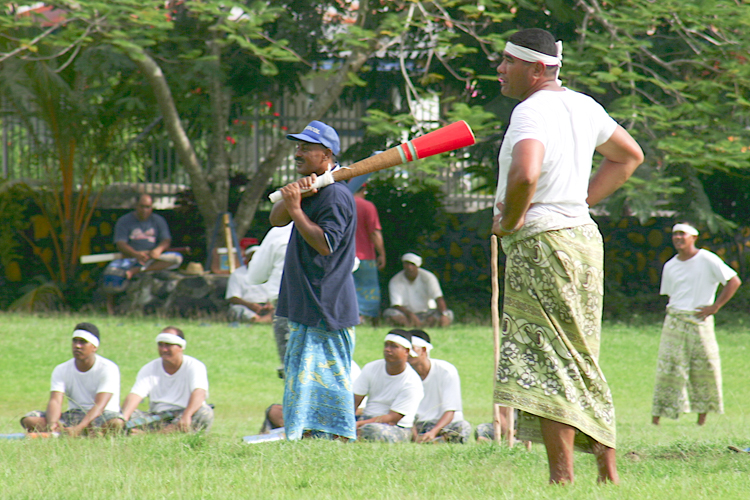
Krikiti
One of the players spotted us and ambled over. We handed him a few dollars which entitled us to descend some steps by a derelict church to a stony beach, where a limpid freshwater stream emerged slowly from a rock cave before trickling between some rocks down into the sea. About half a dozen Samoans lounged about on the edge of the pool. We were extremely hot and sticky, and so quickly got changed and entered the beautiful cool crystal water. Small fish nibbled at our toenails as we swam into the cave, revelling in the unexpected cold, jet lag and apathy falling away in swathes.
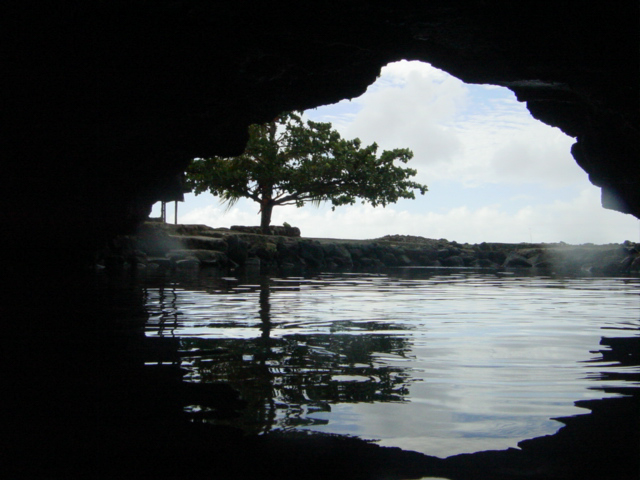
Looking out of our cave

Cool and happy people
After some splashing about, chasing after jewelled crabs, and diving for pieces of loose coral, we emerged once more into the sunshine, two very different and much happier people. As we clambered back up the steps, I noticed a rubber ball lying in the grass. Off to one side, Krikiti players were combing the bushes, so I picked it up and lobbed it back. Smiling their thanks, they restarted their game.
Suitably refreshed, cool, and with our jet lag at bay, we were able to pay attention for the first time to the countryside around us. On the taxi ride back to Apia, we passed through a number of villages, the houses ranging in style from simple fale (raised wooden platforms with a thatched roof and no walls) to fully-fledged stone houses. Dominant features were the open-plan meeting places, the ornately decorated family graves in each front garden, numerous wild dogs, and the roadside platforms designed to protect the garbage from them until the refuse truck came by. Any structure that boasted walls was lovingly decorated with paint and fabric in bold colours. The graves were painted brilliant white, and decorated with black volcanic stones.
For lunch we’d already had “Samoan Pizza”, which was topped with ham and egg and was evidently a local joke; now we could see the point, because everywhere were pigs and chickens.
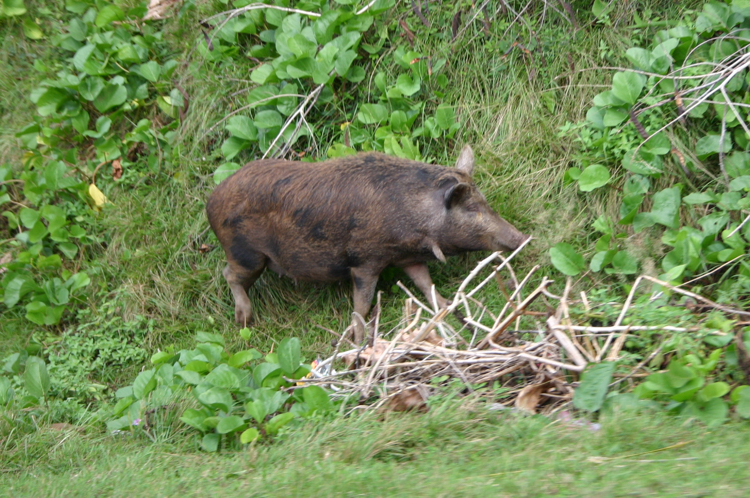
Samoan pig
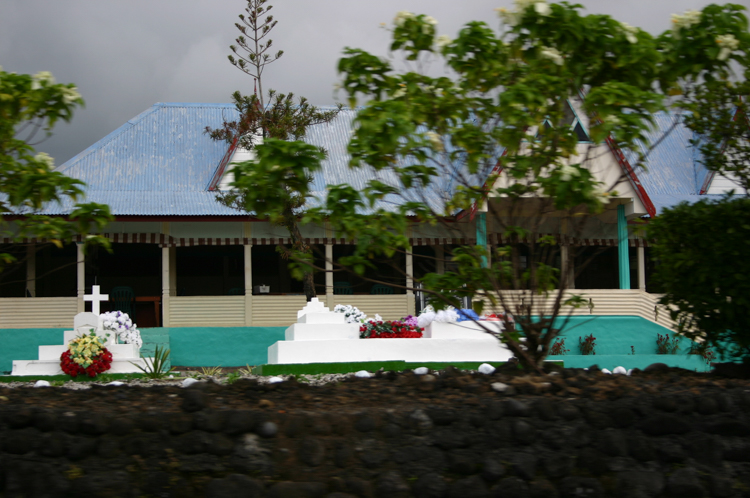
Family graves are usually found in the front garden

Typical family home near to Apia
In one village, hundreds of Samoans lounged in and around one of the large meeting fale; apparently, a conference was in progress. In another, what seemed to be the entire population was playing ping-pong. Whenever we saw anyone, their faces were uniformly serious until we smiled or waved, and then huge smiles would break out everywhere in rashes of grins and waves. Everybody seemed so happy and friendly, and indeed, they seemed to have bountiful land and food and everything that they could need. We understood that each village was autonomous, and controlled a particular crop or natural feature, for which a small charge was made to any visitors who wanted to use it. The richest villages tended to control things like water, and indeed we had already encountered a small inkling of this when we handed over our few dollars to swim in the cave.
Back in Apia, the middle of the harbour frontage is dominated by a large colonial-style hotel, the famous a Aggie Grays, relic of the colonial era and occasional home to rich and famous of that age. We had actually tried to book in, but it always seemed to be full, so we decided to go and see what all the fuss was about.
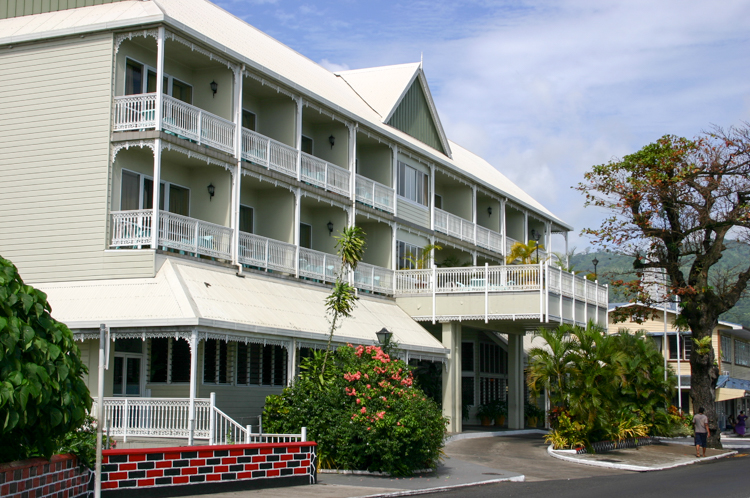
Aggie Grays
It is indeed a charming place, permanently stuck between the world wars, decorated with fading pictures of the natives taken by some long-ago German photographer. When we arrived, the bar was pretty much empty, so we tried the local Valima beer (a nice brew, clean and somehow Canadian) before embarking on a trawl through the cocktail menu. While I started on the Brandy Aggie, essentially a Brandy Alexander made with coconut milk, Bronwyn went straight for the Aggie Special, a mystery drink that came in an enormous glass the size of a goldfish bowl. This turned out to be a pleasant but potent fruit punch, and the white-gloved bar staff broke out into enormous smiles when Bronwyn polished it off and picked up the cocktail menu for another round.
Somewhat later, we lurched back to our hotel where we dined on marlin steaks and white wine, before brushing our teeth alongside the enormous spider under the sink, and falling into a welcome sleep.
Sitting on the patio next morning, a Sunday, drinking our own coffee and munching fresh mango, we watched as white-clad locals streamed toward the many churches that line the street. Samoan church music played on the hotel stereo. As we waited for the kayak guy to show (again), I nibbled at a beautifully crafted “Chinese biscuit” that I’d bought the day before, which looked temptingly like a light pastry flower, but turned out to taste largely of onions.
At ten o’clock, we gave up on the guy again, checked out, and wandered back to the Green Turtle, because we knew that they had his phone number. It turned out that he’d completely forgotten about us, and promised to come and meet us in a couple of hours. Meanwhile, a little strapped for cash after our night of colonial cocktails, we ambled the few hundred metres into town.
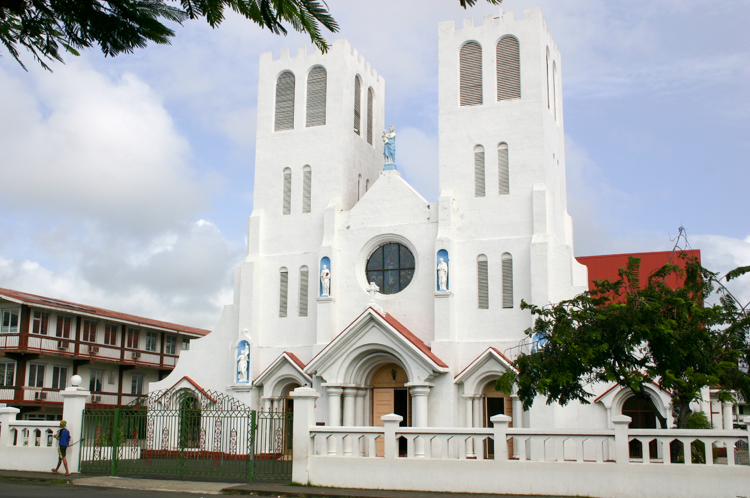
Church in downtown Apia
All the churches were packed. Not only were the large cathedrals full, but the little buildings between them, which I had vaguely supposed to be community centres or offices, were apparently all churches too. In addition, a huge beach fale on the seafront boomed a heavily amplified bass line, and as we got closer, we realised that this, too, was full of people singing. Almost the whole town population was in church. The only people to be seen, scattered lightly under trees and reading on park benches, were Apia’s presumably transient Caucasian population.
The heat beat down. I had chosen to wear a lavalava, the ubiquitous sarong, which proved to be very cool and practical, and a rasher shirt as a defence against sunburn. It was an odd look, but the weather was devilishly hot. Eventually we swallowed our pride and returned to the swishing fans of Aggie Grays, where we ate quiche, and sandwiches with the crusts cut off, with cups of coffee and tea, to the sound of gentle jazz music.
Island time was kicking in. The kayak guy arrived.